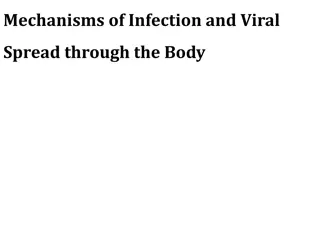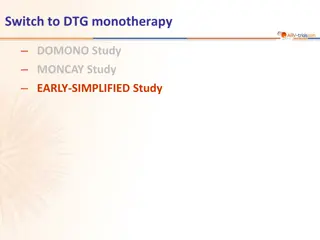Principles of Viral Load Monitoring in HIV Infection
Understanding viral load dynamics in HIV infection is crucial for managing treatment and transmission risks. Viral load monitoring helps assess response to antiretroviral therapy and identify treatment failure. Regular viral load testing is recommended for both adults and children on ART, allowing for early intervention and prevention measures to be implemented.
Download Presentation

Please find below an Image/Link to download the presentation.
The content on the website is provided AS IS for your information and personal use only. It may not be sold, licensed, or shared on other websites without obtaining consent from the author.If you encounter any issues during the download, it is possible that the publisher has removed the file from their server.
You are allowed to download the files provided on this website for personal or commercial use, subject to the condition that they are used lawfully. All files are the property of their respective owners.
The content on the website is provided AS IS for your information and personal use only. It may not be sold, licensed, or shared on other websites without obtaining consent from the author.
E N D
Presentation Transcript
Module 1: Principles of Viral Load Monitoring
Learning Objectives Understand the dynamics of viral load during the course of HIV infection Understand how viral load affects risk for transmission and progression of HIV Explain how viral load responds to antiretroviral therapy (ART) Identify treatment failure using viral load Describe schedule of viral load monitoring
Outline Understanding Viral Load Viral Load and HIV Infection Disease Progression Disease Transmission Viral Load Measurement and Reporting Viral Load Response to ART Treatment Failure Criteria Routine and Targeted Viral Load Monitoring Schedule of Viral Load Monitoring
Introduction: What is Viral Load? (1) Viral load is the concentration of HIV RNA copies in blood. This is a reflection of ongoing virus replication in a person s body.
Introduction: What is Viral Load? (2) Viral load is used as an indicator of: Response to ART and risk for clinical disease progression Risk of transmission of HIV between sex partners Risk of transmission of HIV from mother to child Since 2013, WHO guidelines recommend routine viral load testing for all HIV-infected children and adults on ART DHHS Guidelines, 2013; Murray et al, AIDS 1999; Marschner et al, JID 1998; Thiebaut et al, AIDS 2000
Viral Load during HIV Disease Acute infection: Viral load rises rapidly and often to very high levels (>1 million c/ml) 6-12 weeks after infection:Immune response reduces viral load to steady level ( set point ) Set point predicts disease progress, higher set point indicates a more rapid progression to AIDS Without ART, viral load increases over several years, gradually and then more rapidly as symptoms develop www.youngdayschool.edu.uy
Viral Load and HIV Transmission Rate of transmission: 23 per 100 person-years Rate of transmission: 2.2 per 100 person-years Zero transmissions HIV viral load (copies/ml) Quinn et al., NEJM 2000
Viral Load Measurement Viral load can be measured using whole blood, plasma, or dried blood spots Assays quantify HIV viral load as RNA copies/ml, also reported on a log10 scale Lower limits of detection vary with assays (e.g.<20, 50, 400 copies/ml) Optimal results include target not detected, or the lower limits of detection
Viral Load Log Scale Viral RNA copies/ml of plasma Log-scale: a 1-log change = 10-fold change Viral load changes less than 1 log are generally not of clinical significance Log10 scale Copies/ml 1.0 10 1.5 32 2.0 100 2.5 316 3.0 1,000 3.5 3,162 4.0 10,000 4.5 31,623 5.0 100,000 5.5 316,228
Viral Load Result Categories Once VL lab report is received classify results as follows: <1,000 copies/ml >1,000 copies/ml <1,000 copies/ml >1,000 copies/ml Suppressed Results below lower limit of detection Results up through 999 (e.g. not detected, < 20, 367 copies/ml, 934 copies/ml) Includes all results greater than or equal to 1,000 copies/ml (e.g. 2,000 copies/ml, 30,000 copies/ml, 100,00 copies/ml)
Virologic Response to ART ART prevents HIV replication by inhibiting viral enzymes causing the viral load to decline The goal of treatment is to achieve a suppressed viral load: Associated with better clinical outcomes Lower risk of HIV transmission Persistent viral replication while taking ART can lead to resistance to one or more antiretrovirals (ARVs)
Virologic Response to ART Viral load <1000 copies/ml is considered acceptable Risk of transmission and disease progression <1,000 copies/ml is low In most patients taking ART, the viral load should be <1000 copies/ml after 6 months of treatment Those with high baseline viral load, such as infants, may take longer to achieve suppression VL target: <1000 copies/ml Better outcome Lower risk of transmission DHHS Guidelines, 2013; Tsibris and Hirsch, PPID 2010; Kaufmann et al., Arch Intern Med 2003
Immunologic and Clinical Responses to ART with Viral Suppression With viral suppression: CD4 count increases 50 to 150 cells/ l expected in the 1st year 50 to 100 cells/ l expected in the 2nd year Improved clinical status (weight gain, resolution of diarrhea, no new opportunistic infections)
Monitoring for Treatment Failure Treatment failure can be defined using the following criteria: Clinical Immunologic Virologic Resource-limited settings have relied on suboptimal clinical and immunologic methods May not detect early failure Some with clinical or immunologic failure may not actually have virologic failure
How Does Virologic Monitoring Compare to Clinical or Immunologic Monitoring? to Clinical or Immunologic Monitoring? How Does Virologic Monitoring Compare Virologic monitoring has greatersensitivity and positive predictive value for detecting treatment failure than clinical or CD4 criteria. Increased Sensitivity Higher Positive Predictive Value Earlier detection Timely regimen changes Decreased time with ongoing viral replication May prevent drug resistance and decrease transmission risk Less misclassification Helps prevent unnecessary switches to second-line ART in those who are actually suppressed Kantor et al., CID 2009; Rawizza et al., CID 2011; Mermin et al., BMJ 2011
Viral Load, CD4 and Clinical Criteria for Treatment Failure Viral load (virologic monitoring) is more sensitive and reliable for determining treatment failure for those on ART compared to clinical monitoring or CD4 criteria (immunologic monitoring). www.slideshare.net
Criteria for Treatment Failure Determined by Viral Load Virologic treatment failure: Persistent plasma viral load >1000 copies/ml when measured at least 6 months after starting ART Persistent defined as >2 consecutive viral load results 3 months apart with adherence support between measurements
Routine and Targeted Viral Load Monitoring Routine Viral Load Monitoring Targeted Viral Load Monitoring Ideally, viral load should be measured at regular intervals for all those on ART to monitor response to treatment and for early detection of treatment failure In settings where routine viral load is not feasible or available, viral load testing should be used to confirm treatment failure if suspected by CD4 or clinical criteria
WHO 2016 Guidelines: Viral Load Schedule Check viral load 6 months after ART initiation If 1000 copies/ml , then repeat testing 6 months later, then repeat at least every 12 months if remains 1000 copies/ml If viral load is >1000 copies/ml, provide adherence support and re-check in 3 months Virologic failure only if repeat viral load result is still >1000 copies/ml after adherence support Those with high baseline viral load, such as infants, young children and some adults, may take longer to achieve suppression
Routine and Targeted Viral Load Monitoring Adapted from WHO Guidelines
Adherence Interventions Improve Suppression of Viral Load 53% of those with initial VL >1,000 copies/ml achieved virologic suppression after early viral load testing and a targeted intensive adherence intervention Orrell et al., Antivir Ther 2007
Enhanced Adherence Counseling Enhanced Adherence Counseling is a continual and repeated process that involves: Step 1: A structured assessment of current level of adherence Step 4: Develop and individualized adherence intervention plan Step 2: Exploration of the specific barriers the patient must overcome Step 3: Motivating and assisting patients to identify solutions and address barriers Repeat Steps 1-4 during follow-up sessions.
Achieving Good Adherence Adherence sessions should be repeated until good adherence is achieved Once good adherence is achieved, set a date for repeat viral load measurement after 3 months of good adherence and provide to patient
Viral Load Monitoring: Not Too Much, Not Too Little More evidence is needed to determine the optimal schedule for viral load monitoring. Monitoring too often: Resource intensive, costly and may not contribute to improved patient outcomes If improperly implemented may lead to premature regimen change (e.g. viral load testing prior to expected time of suppression, or repeat viral load testing without improvement in adherence) Infrequent monitoring may lead to late detection of treatment failure and progression of disease In partially adherent patients delayed viral load testing may allow for emergence of drug resistance
Schedule for Routine Viral Load Monitoring Adults (Non-Pregnant or Breastfeeding ) Fill in schedule according to national guidelines
Schedule for Routine Viral Load Monitoring Children and Adolescents on ART Fill in schedule according to national guidelines
Schedule for Routine Viral Load Monitoring Pregnant or Breastfeeding Women on ART Fill in schedule according to national guidelines
Role of CD4 Count Tests For those not on ART: CD4 test at baseline and every 6 months to prioritize for ART and determine opportunistic infection (OI) prophylaxis For targeted viral load monitoring: CD4 test every 6 months for those on ART to assess treatment response If routine viral load testing is available: CD4 may no longer be necessary for those on ART with confirmed viral load <1000 copies/ml CD4 may still be useful if ill and OI suspected to assist with diagnosis
CD4 Count Testing Fill in national guidelines on CD4 count testing
Question 1 Which of the following patients has the highest risk of transmitting HIV during an unprotected sexual act? A. On ARVs with VL = 10,000 copies/ml B. Not on ARVs with VL = 100,000 copies/ml C. On ARVs with VL < 20 copies/ml D. On ARVs with VL = 2,000 copies/ml
Answer Which of the following patients has the highest risk of transmitting HIV during an unprotected sexual act? A. On ARVs with VL = 10,000 B. Not on ARVs with VL = 100,000 C. On ARVs with VL < 20 D. On ARVs with VL = 2,000
Question 2 Patient A has a VL = 3,500 after 6 weeks on ART. This represents treatment failure. A. True B. False
Answer Patient A has a VL = 3,500 after 6 weeks on ART. This represents treatment failure. A. True B. False
Question 3 Patient B has an undetectable VL after 6 months on ART. When is the next VL due? 1. 3 months 2. 6 months 3. 1 year 4. Not needed
Answer Patient B has an undetectable VL after 6 months on ART. When is the next VL due? 1. Not needed 2. 1 year 3. 6 months 4. 3 months
Summary Viral load predicts progression of disease in an individual, and onward transmission of HIV to sex partners or from mother to baby In most individuals, viral load will drop to below levels detectable by viral load blood tests after 6 months of ART Viral load testing is the preferred method for detecting treatment failure for ART patients and should be checked after 6 months on ART At this time, viral load <1000 copies/ml indicates acceptable response to ART (at this time, research is ongoing) Virologic treatment failure: persistent (>2 viral load tests 3 months apart with adherence support in between ) plasma viral load 1000 copies/ml when measured after at least 6 months of ART























